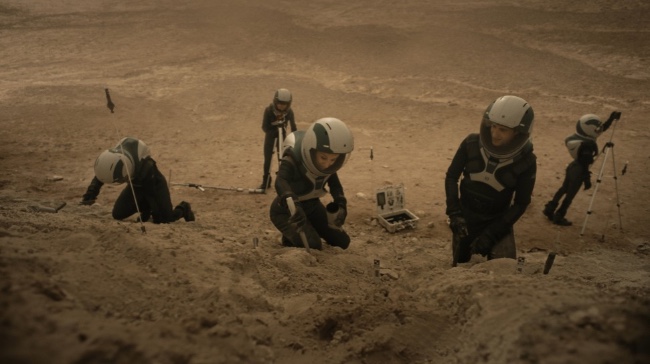
Imagining life in space has been part of our collective fictions for some time. Many of us grew up watching some iteration of Star Trek with our parents or we have a strong opinion on the best Doctor Who or we still say that Firefly was robbed of its rightful hundreds of seasons. As a species, we’re drawn to shows, books, and movies about discovery — humans pushing the boundaries of what we know and where we’ve been. It’s in our very nature to explore.
“For 95% of our existence, we’ve been nomadic,” Stephen Petranek, author of the book How We’ll Live on Mars, says. “Humans are two million-years-old. Up until just 20,000 years ago, we spent our time moving over the horizon to the next area where there was more game, more fruits, and more things that we could eat. Then, we would move beyond that.”
It makes sense then that, now that we’ve explored the corners of our own planet so thoroughly, we would feel the longing to move again. To go beyond the horizon we can see. And Mars is the next great frontier — wild and untamed.
Mars became Stephen Petranek’s scientific obsession when he interviewed Elon Musk for a TED project. Talking to the Tesla visionary and hearing his plans blew Petranek’s mind. Through their conversations, the writer realized that going to Mars wasn’t just possible in the future, the current technology makes it possible now. Bigger still, he felt certain that a mass pilgrimage to the famed “red planet” could save our species from extinction.
No wonder Petranek’s book, How We’ll Live On Mars, grabs people’s imaginations so strongly. This isn’t purely fiction but it does inspire the imagination. Enough so that it became the inspiration for the NatGeo show, MARS — a hybrid of real scientific interviews and scripted drama about the first Martian colony. Recently, we talked to Stephen Petranek in advance of the second season of MARS (out November 12th 9/8c) and he addressed problems on Earth that could still plague us on another planet.
PART I: We’ll have to figure out who owns land on Mars.

The 1967 Space Treaty, modeled after what we did with Antarctica, says no nation can build anything in orbit around the Earth or in space that is a threat to any other nation. So, you can’t militarize space — although it has been militarized to some extent. And no one can own anything outside of Earth’s orbit.
That means if you go to the Moon, you can’t plant a flag on the moon and say the United States owns the Moon. This is contrary to the way it was for many, many years (on Earth). Throughout Earth’s history, explorers would go off to other continents and, even though there were indigenous civilizations, they would plant the flag and say, “This belongs to Spain and this belongs to France”.
About a year before he left office, President Barack Obama made an announcement in which he said, “If you go to a place like Mars, and you establish say, a colony or you decide to mine an area, that would not be against the 1967 Space Treaty.” It’s still unclear whether or not you would own it, but it means, if you get there, you might be able to remove resources or at least live wherever you plant your flag. It’s a squatter’s right interpretation of the ’67 Treaty.
I don’t know if that would hold up under international law or not. Nobody has power or jurisdiction, so it’s totally up in the air. I think it’s probably going to work the way it has throughout most of history — where if you get there and you stake out your claim, you’ll eventually be able to keep it.
PART II: We’ll have to figure out who decides the law of the land.

The absolute truth is, we’re not prepared for this. We don’t have laws on Mars. It’s a completely new frontier. There’s no government. There are no safety nets. But I think things like laws and who owns what will take a secondary place (to staying alive) for quite a long time — at least until there’s a more sustainable population (which Elon Musk believes to be about one million people).
Of course, people are going to misbehave no matter what the numbers are. There’s going to have to be some kind of power structure. I presume, in the beginning — when you have 100 or fewer people, — it’s going to be a relatively militaristic hierarchy. But I suspect again, that people on Mars are going to be so focused on survival and making their lives better that there will be far less misbehavior than we are used to.
There’s a really good example of this, Antarctica. We put about 10,000 people on Antarctica every year on different bases. And there is very little problem with people misbehaving there because it’s so harsh. People are forced to bond with each other and rely on each other for their own survival and well-being. We tend to live pretty independent lives right now, and as long as you don’t break a law or create some trouble, you’re not likely to get noticed. But in a society where staying alive is a matter of cooperation, everyone is watching you. Aberrations from normal behavior, I think, will be noticed very quickly.
PART III: You will have to make the difficult choice to leave Earth forever.

In the beginning, you only want to send people to Mars who really do want to stay and make a life there. Because you’re trying to build a new civilization. If you’re motivated enough to leave Earth forever, you are likely to be pretty darn successful on Mars. And it’s incredibly expensive to go to Mars — the best estimates from Musk put the cost at about $400,000 to get there. So, if a roundtrip ticket is close to a million bucks, there are a lot of people who couldn’t afford it. But also, to maximize the efficiency of getting people to Mars, you need to reuse the rockets. So you need to bring the rockets back. But if you have to fill them up with water for the people aboard, and more people, the costs escalate dramatically.
The idea will be you create a rocket that makes an enjoyable and successful one-way trip. And is then essentially spent. You’ll put a small amount of fuel on it and send it back. Eventually, it gets back to Earth and then gets rebuilt and goes on again.
PART IV: We’ll be dependent on freeze-dried food from Earth and most likely be vegetarians.

We’ll have to use Martian resources in what we build, but the difficulty is you can’t keep people alive by building greenhouses on Mars, at least not initially. You really have to begin terraforming the planet to create an independent food supply. For many years, I suspect that most of the food on Mars, 80%, will arrive from Earth, freeze-dried. The other 20% will be grown in greenhouses, and so you’ll have salads and crunchy things to put in your mouth.
And you can’t afford to feed animals instead of humans on Mars. If you raise animals as a domestic crop, so to speak, you usually have to put about seven calories in every animal for every one calorie you gain back from it. People on Mars will, for a long time, be vegetarians. Because you certainly don’t want to bring animals to Mars that consume resources that humans need to stay alive and to survive.
PART V: People will arrive in large numbers quickly, meaning there is going to be a lot to figure out right away.

Elon Musk, the CEO of SpaceX, intends to start building in or before 2030 these BFR (Big Falcon Rocket) Mars rockets that will each carry 80 people at a minimum to Mars at one time. You can launch to Mars every two years. And these will be reusable rockets. He intends by the year 2050 to have built a thousand of these rockets. So, in other words, by 2050, he imagines that 80,000 people will arrive at Mars in one voyage every two years.
If that’s true, and he’s among the most optimistic people on the face of the Earth, SpaceX would have a million people on Mars within 50 years.
PART VI: But that may not be as challenging as we think.

On Earth, we seem to love growth. Our cities have grown exponentially over the last 50 years. A hundred years ago in the United States, 80% of the people in the country lived on farms in a rural environment. Now the numbers are completely switched. It’s almost 80% that live in urban environments. We have shown on Earth that we can build very quickly from naturally available resources, and the same is going to be true on Mars.
And obviously, people won’t go there if there’s no place for them to live. They can’t live outdoors. They will die. There has to be pre-availability. That’s why, for example, we will send cargo missions to Mars in advance that will land with tons and tons of habitat material and food and machines that make oxygen. It won’t be like the moon where we’re going to visit for a day or two. For the first mission, they have to have what they need to keep them alive when they get there.
VII: This will be humanity’s ultimate wander-lusting adventure.

I would love to go to Mars. I think it would be the greatest and most exciting, most visually stimulating journey in every possible way you can imagine. And the most extraordinary adventure a person could have at this particular point in their lives on Earth. I might not want to be one of the first 10 people to go to Mars — I think that’s going to be difficult. But I wouldn’t mind being number…. 1,001. I’d like to go early before Mars becomes too Earth-like. That way, I can be a hipster who tells people “Mars used to be cool but all the newcomers ruined it.”
The critically-acclaimed show, MARS, returns for season 2, Monday, November 12 9/8c on National Geographic.






